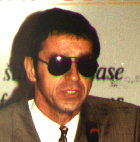
 dr. Borut Juvanec, Ljubljana SI
dr. Borut Juvanec, Ljubljana SI
PROTECTION OR DEVELOPMENT
summary
Protection in architecture means protecting from decay. Buildings can decay because of time and because of man's interventions. Development means something higher, nicer, more useful and more attainable. In architecture both concepts appear: we protect old buildings and protect them, to keep them for our descendants, we develop the wisdoms of yesterday so that our children can build on them.
We protect the monuments and develop the architecture.
The problem appears at the first item: deciding about what to protect and what to develop. The decision is up to the profession. And this is where things start to complicate: we all know architecture, even though only we architects learned it, we document it, analyze it, project it and develop it. Others decide. That is wrong.
One hundred years after the earthquake in Ljubljana and almost one hundred years after Plečnik's first triumph in Vienna, when he brought something new into architecture and this novelty later became an identity (also for Ljubljana and Slovenia), the thought of something like that happening today is an illusion.
This is not wailing: the dentists fix teeth, the farmers plant potatoes but everybody knows architecture. This is not some small marginal problem: architecture was seized by professions whose suggestions are welcome and needed and could form quality entities, but all to often they intervene outside their jurisdictions. We are not dealing only with interventions: for unknown reasons they organise and decide about these topics. That is why we don't have quality pictures, clear and useful documentation, strategies for architecture protection or policy of input of new next to tradition, heritage identity which we talk so much about.
The shaping of our space which shows so much culture, tradition and recognizability, or with other words ARCHITECTURE lost even its name in Slovenian official language: it is called stavbarstvo (the knowledge of construction) instead of architecture. The foolishness does not end here: vernacular architecture as an object is also not architecture but an ethnological monument.
In such circumstances Plečnik and plečniks wouldn't exist.
Theoretically there is no problem: in practice we can simplify it with the Slovenian proverb: everyone should do what he knows how to do.
But there is no problem in that, we all agree on that.


 dr. Borut Juvanec, Ljubljana SI
dr. Borut Juvanec, Ljubljana SI